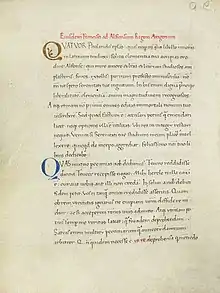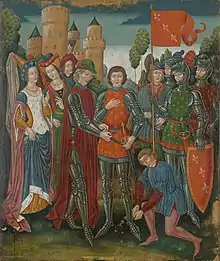Bibliotheca Fictiva Collection
The Bibliotheca Fictiva Collection of Literary and Historical Forgery is the premier library collection in the world that is dedicated entirely to the subject of textual fakery and imposture. The collection totals nearly two thousand rare books and manuscripts and is kept at the Special Collections Department of Johns Hopkins University’s The Sheridan Libraries.

History of the collection

The collection has been built up over more than a half-century by the antiquarian booksellers, collectors, and book historians Arthur and Janet Freeman. The first items were acquired by Johns Hopkins in 2011, and hundreds of additional accessions have enriched the collection ever since.
Scope
The Bibliotheca Fictiva collection spans the entire Western tradition from classical and biblical antiquity to the early-to-mid-twentieth centuries and contains both literary forgeries, and credulous defenses or popular demolition of them. Arthur and Janet Freeman collected works in “the entire range of literary forgery, that is to say the forgery of texts, whether historical, religious, philological, or ‘creatively’ artistic, in all languages and countries of the civilized Western world, from c. 400 BC to the end of the twentieth century” and “sought the original publications of such spuria, and their first and ongoing exposures (or obstinate endorsements), in whatever printed editions seemed most significant (along with manuscripts and correspondence when applicable), with a special emphasis […] on evocative annotated and association copies.” Although they “admitted specimens of the more conventional physical forgeries—faked printings, falsified provenance and ‘autograph’ annotation, etc.”, their main interest lay “in the deceptive creation of spurious text and fictive record, and the history of its investigation and discredit, or indeed its survival in present-day controversy.”[1]
Chronology
Forgeries from antiquity and the Middle Ages

From the first ancient Greek “travel liars,” to the faked epistles of pseudo-Aristeas[2] and Phalaris,[3] fabricated “eye-witness” accounts of the Fall of Troy, and invented epigraphic inscriptions from ancient ruins that never existed, onwards to small oceans of extra-biblical pseudepigrapha, classical and biblical antiquity are amply represented in the Bibliotheca Fictiva collection. Medieval “monkish” forgeries extend to faked patristic homilies and pastoral letters, false ecclesiastical decretals, and invented acts of early Christian councils. The collection contains faked polemics against “Pope Joan” (and their early modern demolition by both Catholic and Protestant critics) and the imaginative, if also often imaginary, chronicles of Asser,[4] Geoffrey of Monmouth,[5] and Godfrey of Viterbo.[6]
Renaissance, Baroque and Enlightment forgeries

The renewed rigor of Renaissance classical scholarship and textual criticism was accompanied by equally ambitious efforts to pour new wine into old bottles, from the “archforger” Annius of Viterbo’s “newly discovered” but impossibly ancient world histories, to Carlo Sigonio’s “lost” Ciceronian treatise on death,[7] and Curzio Inghirami’s scarith “time capusules” claiming to reveal the lost lore and prophecies of the last Etruscans.[8] The Baroque and Enlightenment eras proved to be just as fertile for forgery, including devastating demolitions of several of the most enduring ancient forgeries (e.g., the ‘Donatio Constantini,’ ‘Corpus Hermeticum,’ and the Sibylline Books) and imaginative concoctions of others, including an Elizabethan invention of Anglo-Saxon laws as precedents for contemporary trade protectionism,[9] and the runic “facsimile” of the fake Icelandic “Hjalmar” saga.[10]
Literary plagiarism and opportunistic false attributions allowed would-be hack writers to capitalize on the success and fame of actual best-selling authors including, among their many victims, Samuel Butler, Laurence Sterne, and Henry Fielding[11] to name but a precious few. So too must be counted the inventions of William Lauder—the would-be critic who falsely “exposed” Milton’s Paradise Lost as plagiary—Thomas Chatterton’s fatal “Rowley Poet” impostures, and James Macpherson’s incredibly popular, and incredibly fake, verses of the “ancient” Celtic bard “Ossian.”[12]
Late modern forgeries

With the advent of “bibliomania” in the late eighteenth and nineteenth centuries, a new brand of pecuniary forgery emerged, purporting to put into the hands of eager, if also impressionable, book collectors literary artifacts that were definitively “too good to be true.” False “autograph” verses purportedly by Martin Luther[13] and Ben Jonson, forged letters alleged to be by Percy Bysshe Shelley,[14] and “inscribed” books from the personal library of Lord Byron were all invented by a host of con artists happy to cash in on a sometimes red-hot trade in antiquarian books and literary “contact relics.” From the sublime to the ridiculous, the Bibliotheca Fictiva also tracks the deceptions of scholar-forgers like John Payne Collier, who mixed convincing fakery with authentic evidence in manuscript and printed forms, and the follies of bibliophiles so eager to bid on impossibly rare books listed in the fake Fortsas auction catalogue that they traveled to attend this well-advertised but nonexistent sale in the tiny provincial Belgian village of Binche.[15]
Latter-day impersonators like “Princess Caraboo” and the Baltimore-born Bata Kindai Amgoza ibn LoBagola, whose persona as a self-described “African Savage” and descendant of the lost tribes of Israel, occupied their moments in the popular imagination for years. So, too, did the racist “miscegenation pamphlet” hoax that sought (unsuccessfully) to bring down Abraham Lincoln’s antislavery Republican party,[16] and the writings of the preposterous eccentric Charles Otley Groom-Napier, whose invented titles of Prince of Mantua, Montferrat, Ferrera, Nevers, Rethel, and Alençon were nearly as elaborate as his published pseudo-scientific vegetarian cures for dipsomania. Nineteenth-century manuscript fakes, such as Constantine Simonides’s antiqued and “ancient” Greek manuscript on vellum revealing the mysteries of Byzantine painting,[17] and a false thirteenth-century French Crusader charter designed to qualify several French families’ arms for prominent display in Louis Philippe’s Salles des Croisades at Versailles,[18] demonstrate the eternal human desire to discover “lost” works. A fine gathering of medieval illuminations on actual early parchment fragments by the so-called Spanish Forger and his imitators fed the appetites of art collectors eager for more traditional alternatives to latter-day expressionist and surrealist works. False memoirs, such as Friedrich Nietzsche’s My Sister and I[19] and William Mannix’s spurious Memoirs of Viceroy Li Hung Chang,[20] are further standouts among the more colorful early twentieth-century holdings.
Access, valorization and digitization
A major exhibition of the Bibliotheca Fictiva collection was held in Johns Hopkins's historic George Peabody Library from October 2014 until February 2015.[21] The allied exhibition catalogue was sold out and reprinted in a revised second edition.[22] A complete item-level printed catalogue is available, and a further ‘Continuation’ of which, enumerating all the additions made to the collection post-2014, will be published in 2022–23.[23] A segment of National Public Radio’s Saturday Edition with Scott Simon[24] offers an introduction to the collection, as well as several magazine articles.[25] An international conference convened at JHU also resulted in a volume of essays inspired by the collection being published by the Johns Hopkins University Press.[26] About one hundred of the earliest and rarest books in the Bibliotheca Fictiva have been digitized in early 2022 and made freely available on the Internet Archive, with the support of the Arcadia Fund, with the hope of much more digital access being provided to the full collection in the coming years.[27] All items in the Bibliotheca Fictiva are also accessible through the JHU online catalogue and Hopkins archival finding aids.
References
- Arthur Freeman, Bibliotheca Fictiva: A Collection of Books and Manuscripts Relating to Literary Forgery, 400 BC–AD 2000. London, Bernard Quaritch Ltd, 2014, pp. xi–xii.
- Aristeas (pseud.), The auncient history of the Septuagint, written in Greeke by Aristeus [sic] ... newly done into English by John Done. London, Nicholas Okes, 1633.
- Phalaris (pseud.), Φαλάριδος καὶ Βρούτου ἐπιστολαι. Phalaridis & Bruti epistolae; his praefixa epistolarum conscribendarum methodus, graecè & latinè [by Kaspar Stiblin and Christoph Casseanus]. Heidelberg: Hieronymus Commelinus, 1597.
- John Asser (pseud.), Aelfredi regis res gestae. [London, John Day, 1574.].
- Geoffrey of Monmouth, Britanniae utriusque regum et principum origo & gesta insignia ab Galfrido Monemutensi ex antiquissimis Britannici sermonis monumentis in latinum traducta, & ab Ascensio rursus maiore accuratione impressa. Paris, Josse Badius, 1517 (2nd ed.).
- Johann Pistorius (ed.), Germanicorum scriptorum, qui rerum a Germanis per multas aetates gestarum historias vel annales posteris reliquerunt. Hannover, Heirs of Claude Marnius, 1613.
- [Carlo Sigonio], M. Tullii Ciceronis consolatio; liber quo seipsum de filiae morte consolatus est, nunc primum repertus & in lucem editus. Venice, Girolamo Polo, 1583.
- Curzio Inghirami, Ethruscarum antiquitatum fragmenta, quibus urbis Romae, aliarumque gentium primordia, mores, & res gestae indicantur. ‘Frankfurt’ [i.e. Florence: Amadore Massi], 1637.
- Laurence Nowell, William Lambarde, [Laws of King Ine]. Ca. 1565.
- [Lucas Halpap], [Nils Rabenius?], Johan Peringskiöld (trans.), Historia Hialmari regis Biarmlandiæ Atque Thulemarkiæ, Ex Fragmento Runici M[anu]s[crip]ti literis recentioribus descripta, Cum gemina versione Johannis Peringskioldi. [Stockholm?], ca. 1710.
- Louis Laurent Joseph Gain de Montagnac. Mémoires du Chevalier de Kilpar, traduits ou imités de l’anglais de M. Fielding. Paris: Chez la veuve Duchesne, 1768 (two vols in one).
- James Macpherson. Fingal, an ancient epic poem, in six books; together with several other poems, composed by Ossian, the son of Fingal; translated from the Galic language. London, Thomas Becket and P.A. De Hondt, 1762.
- Hermann Kyrieleis, [Martin Luther (pseud.)], [Forged manuscript of ‘Das Vatter Unser’, a poem in nine three-line stanzas ostensibly inscribed to Jacob Dolly by Martin Luther, ca. 1893-96].
- Percy Bysshe Shelley (pseud.), Letters of Percy Bysshe Shelley, with an introductory essay by Robert Browning. London, Edward Moxon, 1852.
- Renier Hubert Ghislain Chalon, Catalogue d’une très-riche mais peu nombreuse collection de livres, provenant de la bibliothèque de feu M.r le Comte J.-N.-A. de Fortsas, dont la vente se fera à Binche, le 10 août 1840. Mons, Emmanuel Hoyois, [1840].
- [David Goodman Croly & George Wakeman], Miscegenation: the theory of the blending of the races, applied to the American white man and Negro. New York, Dexter, Hamilton, and Company, 1864.
- Constantine Simonides, Συμαϊς [Autograph manuscript of 52 leaves in (demotic) Greek minuscule, a history of Byzantine painting in Simonides’ native island of Syme; purportedly by one Meletios, a monk of Chios, and completed on Mount Athos]. [17th century or earlier, but in fact c.1850].
- “Charte de Nolis pour la traverse de trois chevaliers Bretons vers Damiette,” [Manuscript on medieval parchment]. Limassol, Cyprus, 1249 [Paris, ca. 1840].
- Friedrich Wilhelm Nietzsche (pseudo), My sister and I; translated and introduced by Dr. Oscar Levy. New York, Boar’s Head Books, 1951.
- William Francis Mannix, Memoirs of the Viceroy Li Hung Chang; with an introduction by the Hon. John W. Foster. London, Constable, 1913.
- Fakes, Lies, and Forgeries Exhibit at the George Peabody Library in Fine Books & Collections
- Earle Havens (ed.), Fakes, Lies, and Forgeries: Rare Books and Manuscripts from the Arthur and Janet Freeman Bibliotheca Fictiva Collection. Baltimore, Sheridan Libraries, 2014; 2nd ed. rev., 2016.
- Arthur Freeman, Bibliotheca Fictiva: A Collection of Books and Manuscripts Relating to Literary Forgery, 400 BC–AD 2000. London, Bernard Quaritch Ltd, 2014.
- “Jesus Started A Chain Letter — And Other Hoaxes.” NPR Weekend Edition Saturday, 09-11-2-14.
- Dale Keiger, “Sham Text.” Johns Hopkins Magazine 64:3 (Fall 2012), 44–49; Earle Havens, “Bibliotheca Fictiva: The Arthur and Janet Freeman Collection of Rare Books in the History of Literary Forgery,” Fine Books & Collections Magazine 12:4 (Autumn 2014), 54–59.
- Walter Stephens and Earle Havens, assisted by Janet Gomez (eds.), Literary Forgery in Early Modern Europe, 1450–1800 (Johns Hopkins University Press, 2018).
- Bibliotheca Fictiva on the Internet Archive